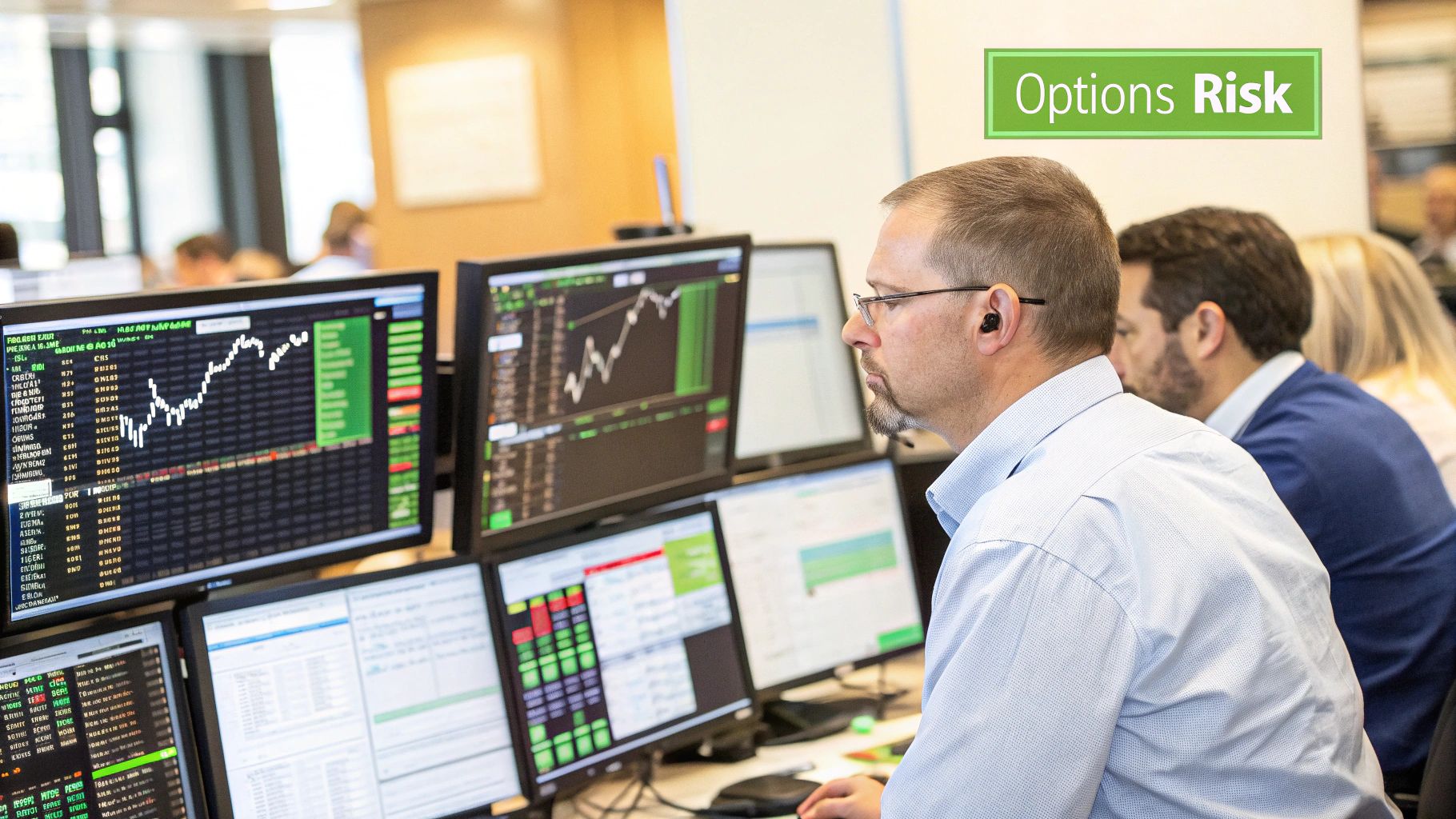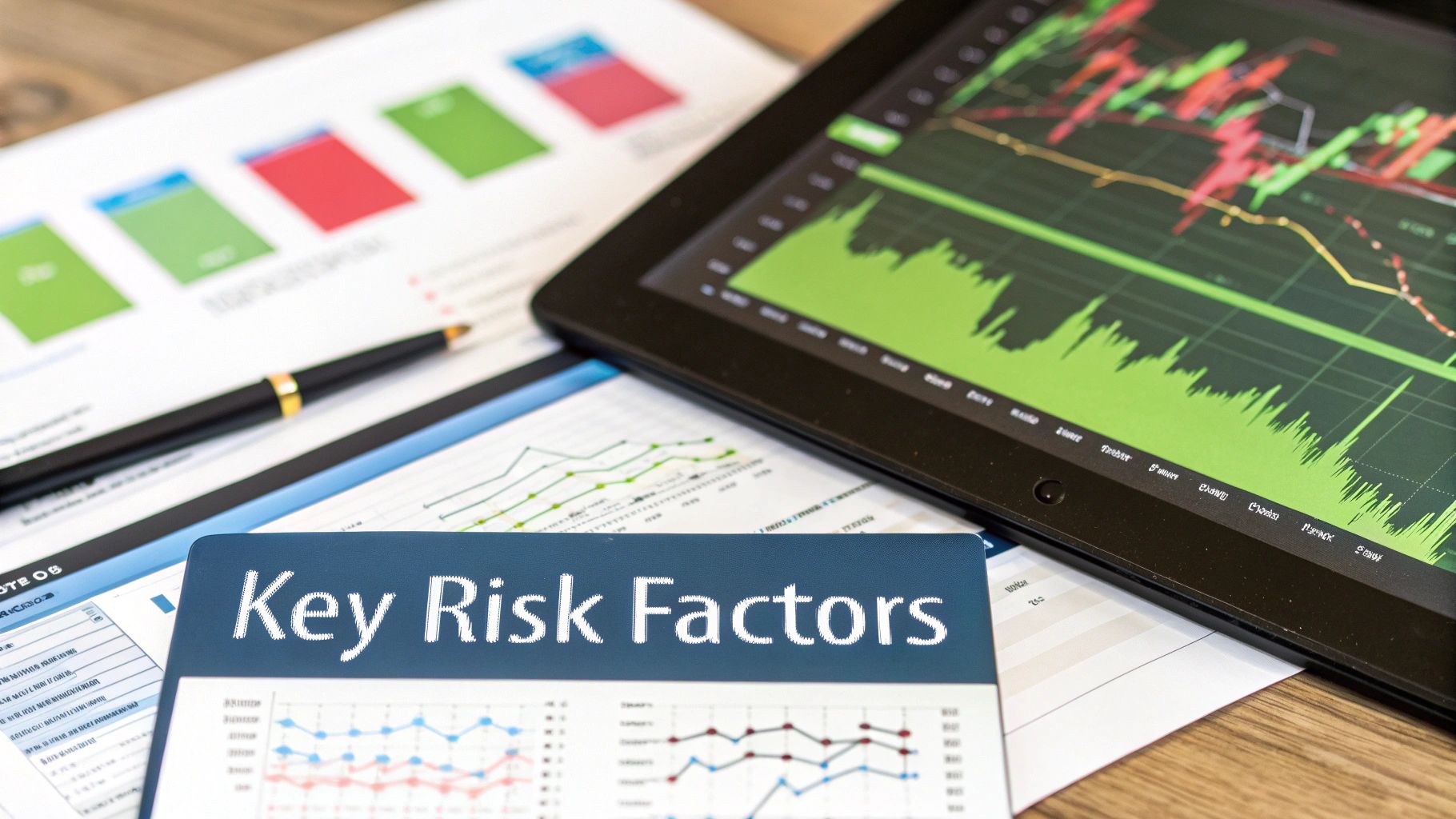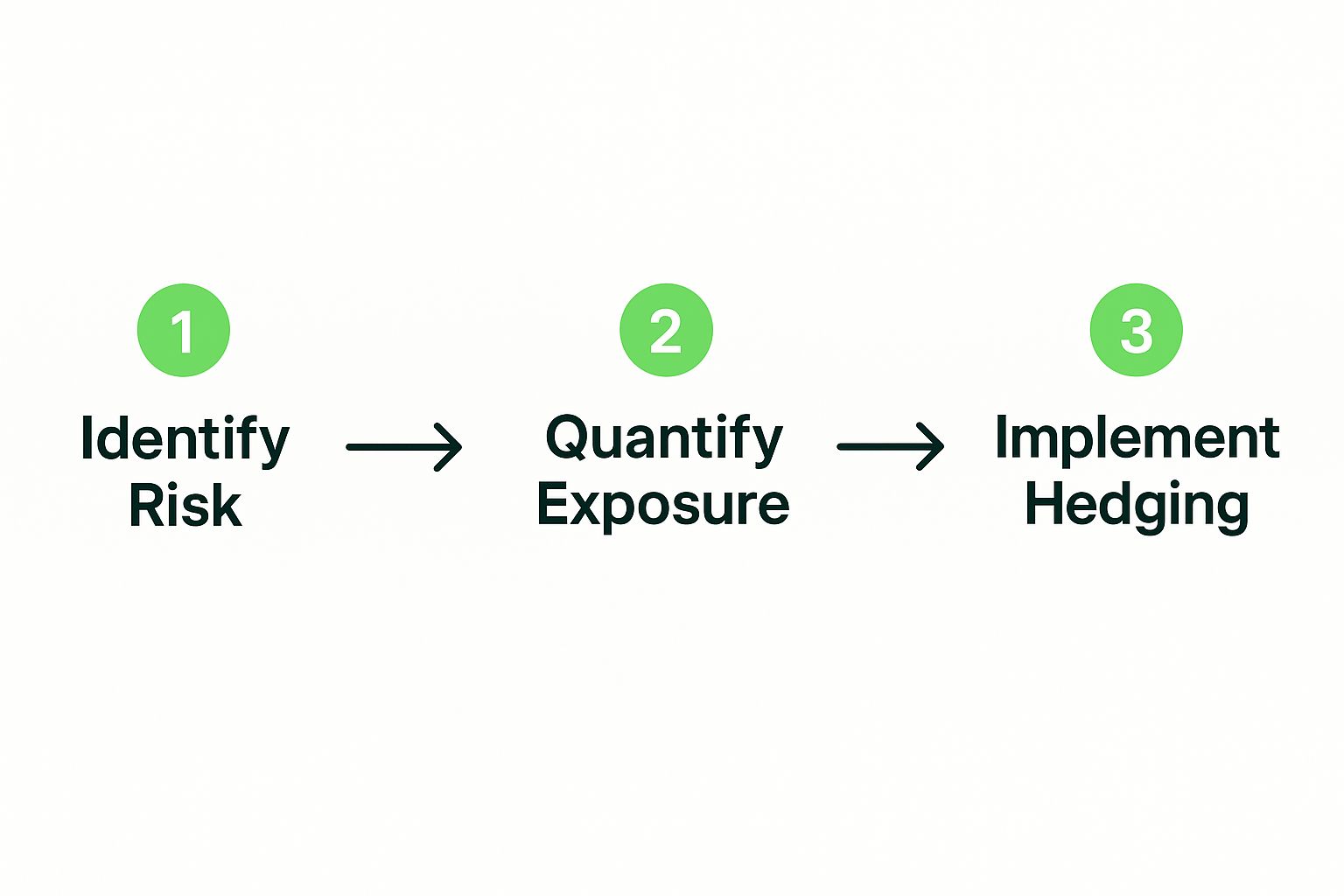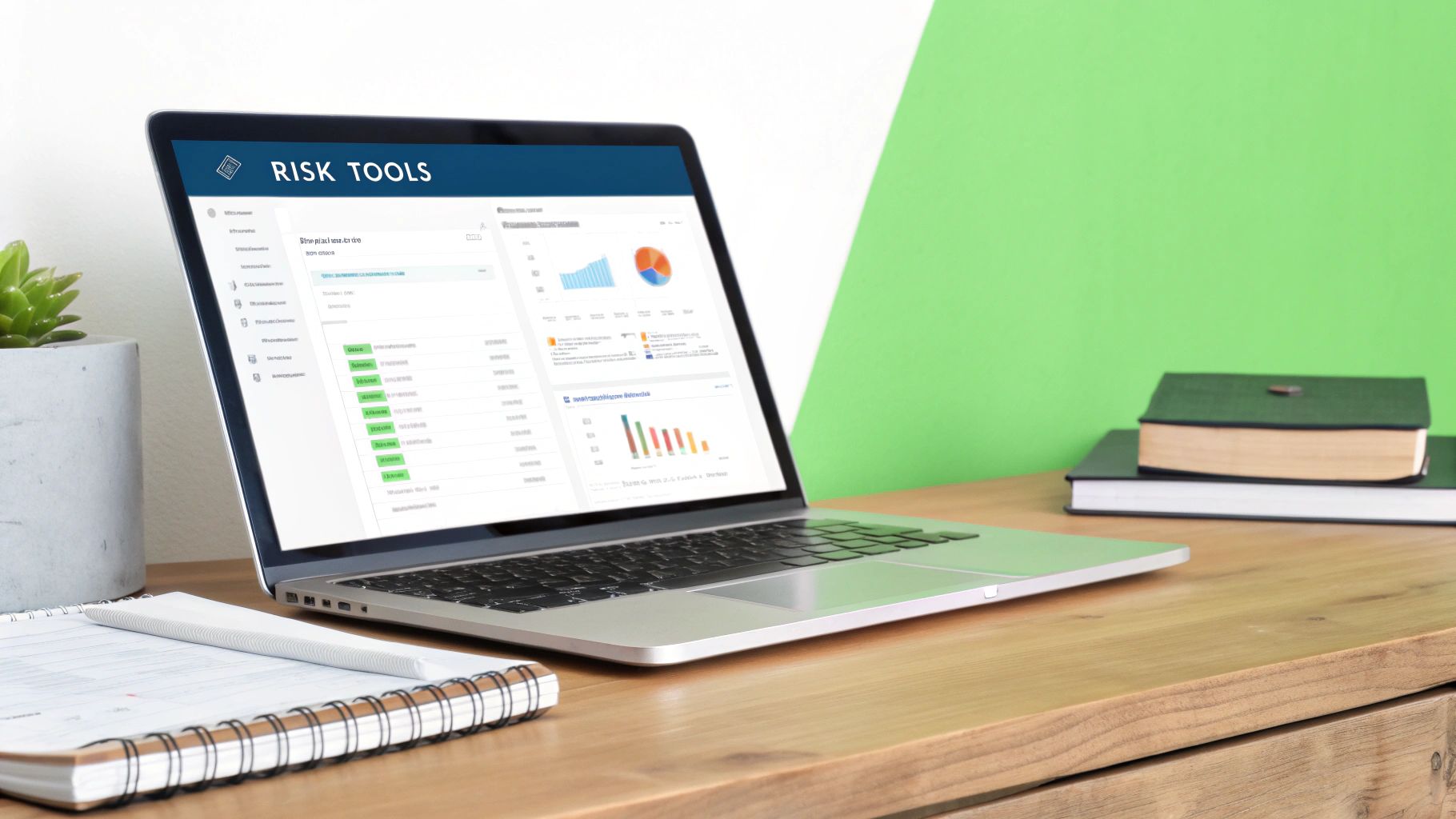Master Options Risk Management Strategies to Protect Your Portfolio
If a stock moves past your strike, the option can be assigned — meaning you'll have to sell (in a call) or buy (in a put). Knowing the assignment probability ahead of time is key to managing risk.
Posted by
Related reading
A Practical Guide to Generating Income with Covered Call Options
Learn how to generate consistent income using covered call options. This guide breaks down the strategy, risks, and rewards with real-world examples.
Selling Naked Put (selling naked put): A Practical Guide to Income and Risk
Discover how selling naked put options can generate consistent income while managing risk. Practical strategies, real-world examples, and step-by-step guidance.
Risks of Covered Calls: risks of covered calls explained
Discover the risks of covered calls and how to navigate gains limits, assignment pitfalls, and smarter income strategies to protect your portfolio.
If you're going to last in the world of options trading, you need to get one thing straight: managing risk isn't just a good idea, it's everything. It’s the practice of spotting, analyzing, and defending against the financial dangers that come with every single options contract you trade.
This isn't just about grabbing profits. It's about playing defense to protect your capital so you can stay in the game long enough to win. This is how you ensure long-term survival in the markets.
Building a Bulletproof Risk Framework

Before you even think about placing a trade, you have to accept that risk management is an active job. It’s the foundation of a real trading career, not just a box you tick. So many new traders see risk as a monster to run from, but those of us who've been around a while see it differently. We see it as a variable we can measure, understand, and ultimately control.
That mental shift is what separates the pros from the rest.
Instead of being scared of a volatile market, you learn to put a number on it. Instead of guessing, you start making moves based on probabilities and rules you've already set for yourself. This framework is the bright line between traders who are consistently profitable and those who have a great month followed by a blown-up account.
The Core Principles of Risk Control
A solid risk framework is built on a few non-negotiable ideas. Get these into your head, and you'll completely change how you look at every trade.
- Capital Preservation First: Your number one job isn't making money. It's protecting the money you have. Profits come after you get your risk control right.
- Risk as a Known Quantity: You should never, ever enter a trade without knowing the exact dollar amount you could lose and what has to happen for that loss to become real.
- No Single Trade Dominance: One bad trade shouldn't be able to sink your ship. Disciplined position sizing is how you make sure of that.
These aren't just textbook theories; they're the survival rules for playing in an unpredictable sandbox. For a deeper look at these concepts, our complete guide on options trading risk management breaks down even more strategies.
To make this crystal clear, let's lay out these pillars in a simple table. This is what separates guessing from professional trading.
Key Pillars of Options Risk Management
This table outlines the essential concepts and their real-world application for any trader serious about managing options risk.
| Pillar | What It Really Means | How You Apply It |
|---|---|---|
| Capital Preservation | Your trading capital is your lifeblood. Protecting it is more important than chasing any single gain. | Set a hard stop-loss on every trade. Never risk more than 1-2% of your total account on one position. |
| Known Risk | Don't trade on a "feeling." Know exactly what you'll lose if the trade goes south before you enter. | For every trade, define your max loss in dollars. If the trade hits that point, you exit. No exceptions. |
| Position Sizing | A single trade should never have the power to cause catastrophic damage to your account. | Your position size is determined by your stop-loss, not the other way around. Smaller stops allow for larger positions. |
Wrapping your head around these concepts is the first step.
The goal isn't to eliminate risk entirely—that’s impossible. The goal is to take only calculated, well-understood risks where the potential reward justifies the exposure. This is the essence of professional trading.
Ultimately, building this framework is about creating your own personal rulebook. It means defining your max loss per trade, knowing your total portfolio exposure at all times, and having a clear exit plan before you ever click "buy." This structure pulls emotion and guesswork out of the equation, leaving you with a disciplined, repeatable process that can handle whatever the market throws at it.
Using Probabilities to Guide Your Trades

Let's get one thing straight: successful options trading isn't about having a crystal ball. It’s about playing the odds intelligently. Forget trying to guess which way a stock will zig or zag. The pros shift their focus to the statistical likelihood of different outcomes.
This simple change in perspective is what turns trading from a pure gamble into a calculated business. The key is leaning on probability-based metrics that are already built into most trading platforms. These numbers give you an objective edge, helping you sidestep those low-probability flyers and consistently place trades with the stats on your side.
Understanding Key Probability Metrics
So, how do we measure these odds? Two of the most powerful metrics you'll find are Delta and Probability of Profit (PoP). While they measure slightly different things, they both help answer the most critical question: What are my chances of this trade actually working out?
Delta as a Probability Proxy: Most traders know Delta as the metric that shows how much an option's price will move for every $1 change in the stock. But it has a second, equally important job: it serves as a quick estimate of the probability that an option will expire in-the-money (ITM). For example, a call option with a .30 Delta has roughly a 30% chance of finishing ITM.
Probability of Profit (PoP): This one is more direct. PoP calculates the statistical likelihood that your trade will be profitable by at least $0.01 at expiration. A trade with a 75% PoP is, statistically speaking, expected to be a winner three out of four times if you hold it all the way through.
Using these numbers, you can instantly size up the risk of any potential trade. A high-premium, long-shot bet might look tempting on the surface, but the math will quickly tell you if it's a losing game over the long haul.
The Statistical Edge for Option Sellers
This probability-first approach is an absolute game-changer for option sellers. Remember, their goal is for the options they sell to expire worthless, which lets them pocket the entire premium they collected upfront. It turns out the market has a natural tendency that gives sellers a head start.
A core insight for any option seller is that most options expire worthless. Data from the Chicago Mercantile Exchange shows that roughly 76.5% of options held to expiration are not exercised. That's a massive statistical tailwind. You can dig deeper into these options trading risk dynamics on barchart.com.
Now, this doesn't mean selling options is a risk-free lunch. An unmanaged position can blow up and lead to huge losses. But it does mean that sellers begin with a statistical advantage baked right in.
By consistently selling options with a high probability of expiring out-of-the-money (OTM)—like those with a low Delta—sellers are aligning their strategy with this powerful market tendency.
Think about it: selling a call option with a .20 Delta means there's an estimated 80% chance it expires worthless. This is the foundation of a durable strategy—building a business based on collecting premium from high-probability trades. It's all about letting the law of large numbers work for you, not against you.
Smart Position Sizing and Setting Stop Levels
There are two disciplines that really separate the traders who stick around from those who blow up their accounts: how much capital you risk on any single trade, and having an exit plan you actually stick to.
Getting a handle on position sizing and stop levels turns options trading from a casino trip into a manageable business. Honestly, it's the core of practical options risk management.
This isn't about being scared; it's about being smart. A good stop level is like a circuit breaker—it stops a small, acceptable loss from turning into a disaster. Likewise, smart position sizing makes sure that a string of bad luck can't take you out of the game. Get these wrong, and even the best strategy will eventually fail you.

This visual is a great reminder that protecting your capital is a deliberate process, not just a gut reaction. It's about spotting a threat and actively hedging against it before it gets out of hand.
Calculating Your Position Size
First things first: forget about how many contracts you "feel" like buying. Your position size should always, always be a mathematical function of your account size and how much you're willing to lose on one trade.
The professional standard here is the 1% rule. It's simple: you never risk more than 1% of your total trading capital on a single idea.
Let's make this real.
- Account Size: $25,000
- Risk per Trade (1%): $250
That $250 is your hard limit for what you can lose on this trade. It dictates every other decision. If you're looking to buy a call option that costs $2.50 per share (or $250 per contract), the 1% rule means you can only buy one single contract. If the trade goes completely sour and the option expires worthless, you've lost exactly your predefined risk amount. No more, no less.
Setting Intelligent Stop Levels for Options
Deciding where to cut your losses is just as important as deciding what to buy. With options, you’ve got a few logical ways to set your stop-loss, and the best one often comes down to your specific strategy.
Premium Percentage Loss: This is the most direct method. You simply decide to get out if the option's value drops by a certain percentage, say 50%. If you paid $3.00 for a call ($300 per contract), your stop-loss would trigger if its price falls to $1.50. This cleanly defines your risk on the option itself.
Underlying Stock Price Level: Often, your entire reason for entering a trade is based on what the underlying stock is doing. You might decide to exit your call option not because of the premium's price, but because the stock itself broke through a key support level. If that happens, the original thesis for your trade is no longer valid.
Change in Volatility: For certain strategies, like many of those covered in our guide to options selling strategies, a sudden spike in implied volatility (IV) is a huge red flag. Rising IV can torch a short option position and dramatically increase your risk, even if the stock price has barely budged.
Your stop-loss isn't a sign of failure; it's a tool for capital preservation. A professional trader views hitting a stop as the successful execution of their risk plan, allowing them to move on to the next opportunity with their capital intact.
At the end of the day, your goal is to make risk a known, fixed variable. By combining disciplined position sizing with a clear, pre-determined exit point, you neutralize the two biggest emotional threats to your account: greed and fear. You build a system that protects you from your worst instincts, ensuring you'll be here to trade tomorrow, next week, and for years to come.
Using Options to Hedge Your Portfolio

Most people think of options as tools for high-stakes speculation, but that's only half the story. One of their most powerful uses is actually defensive—acting as portfolio insurance to protect your hard-earned capital.
Using options this way lets you build a more resilient portfolio that can ride out those sudden market drops. The basic idea is simple: you use an option to create a price floor for a stock you own, effectively transforming an unknown risk into a known, fixed cost. It's a practical application of options risk management that savvy investors use to sleep better at night.
Protecting Your Gains with a Protective Put
The most straightforward way to hedge is with a protective put. Think of it exactly like buying insurance on your house. You pay a relatively small premium to protect a high-value asset from a catastrophic event.
Let's walk through a real-world scenario. Imagine you own 100 shares of XYZ Corp. You bought them at $45, and the stock is now trading at $60 per share. You're sitting on a nice unrealized gain, but you're getting nervous about a potential market correction wiping it out.
To lock in those profits, you could buy one put option contract (which controls 100 shares) with a strike price of $55.
- Your Position: 100 shares of XYZ at $60.
- The Hedge: Buy one $55 strike put option.
- The Cost: Let's say the premium for this put is $2 per share, or $200 total.
By making this trade, you've just guaranteed yourself a minimum sale price. If XYZ stock tanks and plummets to $40, your put option gives you the right to sell your shares for $55 anyway. Your loss is capped, while your upside remains totally open if the stock keeps climbing.
Reducing Hedging Costs with Collars
Buying puts is effective, but it's not free. That premium cost can eat into your overall returns. A more advanced strategy to offset this expense is known as a collar.
A collar is a two-part move:
- Buy a Protective Put: Just like before, you buy a put to set your price floor.
- Sell a Covered Call: Then, you sell a call option with a higher strike price (say, $65).
The cash you collect from selling the call helps pay for the put you just bought. If you structure it right, you can even create a "cashless collar" where the premium you bring in completely covers the premium you paid out.
So what's the catch? The trade-off is that you agree to cap your upside. If the stock soars past your call's strike price, you'll be obligated to sell your shares at that price. You give up lottery-ticket potential for rock-solid protection.
This strategic use of options is a cornerstone of advanced risk management. The leverage they provide means a relatively small premium can control a large underlying asset, making them incredibly efficient for setting price floors and limiting your downside.
To get a handle on your portfolio's overall risk and find the best hedging opportunities, you might want to explore powerful portfolio analysis tools. Ultimately, these defensive moves give you control, letting you protect your portfolio proactively instead of just reacting when the market gets chaotic.
Learning from History to Manage Future Risk
The market has a memory. Some of the most potent lessons in options risk management aren't found in textbooks, but are etched into the charts of past meltdowns. If you ignore this history, you’re basically setting sail without checking the weather—and sooner or later, you're going to get caught in a storm you never saw coming.
Traders who used a "set it and forget it" approach learned this the hard way during recent crises. Their painful experiences drive home a critical point: your risk plan has to be as dynamic as the market itself.
The Anatomy of a Market Meltdown
Think back to the lightning-fast crash in early 2020. As the world reeled from uncertainty, the Volatility Index (VIX) exploded, screaming extreme fear. For anyone selling options, this was a gut-check moment. Those who had sold puts without a clear escape plan watched their positions go from profitable to catastrophic in a matter of days.
A trade that looked like a safe, easy-income generator on Monday was a portfolio-crushing liability by Wednesday. This wasn’t just a streak of bad luck. It was a failure to respect how violently and quickly volatility can reprice risk. The traders who made it through—and even profited—were the ones who saw the stress building and acted. They either closed their trades, rolled them to a safer position, or hedged their exposure.
We saw a similar story play out during the 2023 regional banking crisis. A lot of traders had been selling puts on what they thought were boring, stable bank stocks. They woke up one morning to massive price gaps and credit events that made their positions nearly worthless overnight. These events prove that just looking at historical data isn't enough. You need a living, breathing risk management plan. For a deeper dive into how pros use historical data, check out the quantitative insights on intrinio.com.
The biggest takeaway here is simple: The market is never static, so your risk plan can't be either. A strategy that works great in a calm, low-volatility market can become a ticking time bomb when fear takes over.
This is exactly why professional traders are obsessed with stress-testing their portfolios. They don't just ask what could happen; they look at what has happened before and make sure their defenses can handle that kind of pressure.
Stress-Testing Your Strategy
So, how do you apply these lessons yourself? Start by running your current strategies through the gauntlet of past market disasters. This is a non-negotiable part of managing investment risk.
Ask yourself the hard questions:
The 2020 COVID Crash: How would your short puts or covered calls have held up when the VIX shot from 14 to over 80 in just a few weeks? What was your plan? At what point would you have pulled the plug?
The 2023 Banking Crisis: If you were selling puts on a stock that gapped down 50% at the open, was your position size small enough to survive that hit? Did you have a plan for something a normal stop-loss couldn't even touch?
Answering these questions honestly shines a bright light on the weak spots in your risk plan. It forces you to look beyond simple probabilities and prepare for the inevitable "black swan"—the event that statistics say is impossible, but history proves will eventually arrive.
Of course. Here is the rewritten section, formatted to match the provided examples and writing style.
Your Top Options Risk Questions, Answered
Even with the best strategy, real-world trading always throws a few curveballs. When you're putting your capital on the line, questions are a good thing—it means you're thinking like a trader.
Let's dig into some of the most common questions that pop up, especially when you’re trying to move from theory to consistent practice.
What’s the Single Biggest Mistake New Traders Make with Risk?
Hands down, it's getting the position size completely wrong. New traders see the incredible leverage options offer and get stars in their eyes. They start betting way too much on a single idea.
It only takes a couple of trades going south to cripple an account if your positions are too big. A professional mindset starts here: No single trade should ever have the power to cause catastrophic damage. A solid rule of thumb is to risk no more than 1-2% of your total trading capital on any one setup. That discipline is what keeps you in the game long enough to win.
Should I Use Mental Stops or Hard Stop-Loss Orders?
This really boils down to your personal discipline and how liquid the option contract is.
Hard stop-loss orders are fantastic for enforcing discipline, especially on highly liquid options. They take the emotion right out of the exit. The downside? A quick, volatile price spike can knock you out of a perfectly good trade, and you might get a bad fill (slippage).
Mental stops give you more flexibility. You can see why the price is moving and decide if the reason for your trade is still valid. But here's the catch: they demand iron-clad discipline. If you hesitate or start second-guessing, you've already lost.
For most traders just finding their footing, a hard stop-loss—or at the very least, a non-negotiable price alert—is the way to go. It builds the critical habit of cutting losses without thinking twice.
How Do the Greeks Actually Help Me Manage Risk?
Think of the Greeks (Delta, Gamma, Theta, Vega) as the real-time risk dashboard for your trade. They go way beyond just looking at the stock price. They tell you how your position is exposed to all the different forces at play in the market.
Getting a handle on them is the key to managing risk proactively instead of just reacting after a big price move.
Here’s a quick and dirty breakdown:
- Delta: How much your option's price will change for every $1 move in the stock. It's your basic directional risk.
- Gamma: Measures how fast your Delta is going to change. Think of it as the acceleration of your risk.
- Theta: The cost of holding your position. This is the amount of value your option loses every single day due to time decay.
- Vega: Your sensitivity to fear and greed in the market. It tells you how much your option's price will change when implied volatility goes up or down.
By keeping an eye on your Greeks, you can anticipate changes and adjust your position before a small problem turns into a big one.
Ready to turn these risk management ideas into a repeatable process for generating income? Strike Price gives you real-time probability metrics and smart alerts to find that sweet spot between safety and premium. Stop guessing and start making data-driven decisions by visiting https://strikeprice.app today.